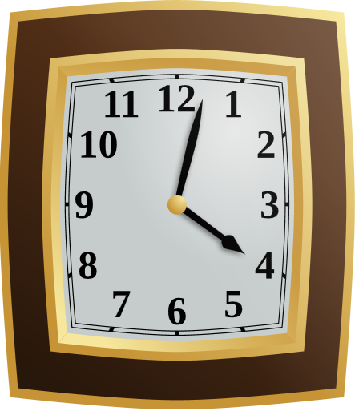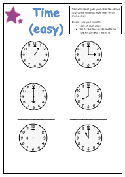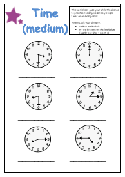Teaching your child to tell the time
When is a good time to start teaching your child how to tell the time? Well, once they can count to twelve or more, why not give it a go?
As always, make it a fun, pressure-free experience – after all, there will be many ‘telling the time’ activities for kids at school so anything they learn beforehand is just a nice bonus.
After you have taught your child the basics you can download our free and printable tell the time worksheet (easy) or our tell the time worksheet (medium) to give them some practice.
Simple ideas to teach children to tell the time
There is no set way to go about this – it is something that will probably come quite naturally to you in any case. But just to give you some ideas, here is how we would go about it:
1. Mention the time all the time
Take the opportunity to mention time and time-related concepts as they arise in everyday situations. For example, some of the things you might say are:
– It is 8 o’clock – time for breakfast I think
– It is nearly 11 o’clock – I had better leave now or otherwise I will be late for my 11 o’clock appointment
– Your swimming lesson is for one hour – it starts at 9 o’clock and finishes at 10 o’clock
– It is 8 o’clock at night – so it is time for you to go to bed
2. Big hand and little hand
Point out to your child that clocks have a big hand and a little hand, and that some have a ‘fast’ hand too (the second hand). When you see a clock ask them to show you which is the big hand and which is the little hand.
3. Twelve means ‘o’clock’
Explain that when the big hand is on the twelve it is ‘o’clock’ and that the number that the little hand is pointing to is the time. So if the big hand is on the twelve and the little hand is on the seven it is seven o’clock. Try to point out real life ‘o’clock examples’.
Understanding the difference between the two hands is just about the most important part in telling the time for kids – so be patient and make it a fun experience.
4. Using time in conversation
Don’t forget to add in phrases like ‘in the morning’, ‘in the afternoon’, ‘at night’, ‘yesterday’ and ‘tomorrow’ into your everyday conversations. For example, one morning you could say ‘Tomorrow afternoon we are going to see grandma’. You could then follow up the next day with ‘This afternoon we are going to see grandma’. Using time words in everyday conversations will provide meaningful context to time so it is not just an abstract concept.
5. Practice
At this point, you may wish to complete the first ‘tell the time’ worksheet with your child. Remember to give them plenty of encouragement, to congratulate them when they get it right and to remain just as positive and upbeat if they make a mistake.
6. Moving beyond the basics
As your child progresses they are likely to be curious about times other than when the big hand is on the 12. Use these opportunities to introduce more complex times. For example if your child sees that it is 9:25 and asks what this means, you might say, ‘Well, the little hand has just passed nine, so it is just after nine o’clock. And look (point to the big hand), the big hand has moved past the 12 and it has almost made it halfway round again – so it is nearly half past 9.’
Obviously if your child is following along very easily, you could explain in more detail what the exact time actually is and give them lots of opportunities to practice telling the time. If your child is at this level of comprehension you should be very proud as this is not something usually taught until children are 7-9 years old, depending on where you live.
7. More practice
At this point, if you feel it will be worthwhile, give your child the second ‘tell the time’ worksheet to try.
Time is everywhere!
Depending on what works best for your child, you may wish to buy them an ‘educational clock’– these are not real clocks, but ones where the hour and minute hand can be manipulated, making it easy for you to set times to help teach them. There are many to choose from – this one is nice, simple and cheap:
You may also wish to hang a working analog clock in your child’s bedroom.
Life will throw up all manner of opportunities to practice telling the time and lots of chances to play telling time games. Have fun with them all.
We could go on, but time has run out!



